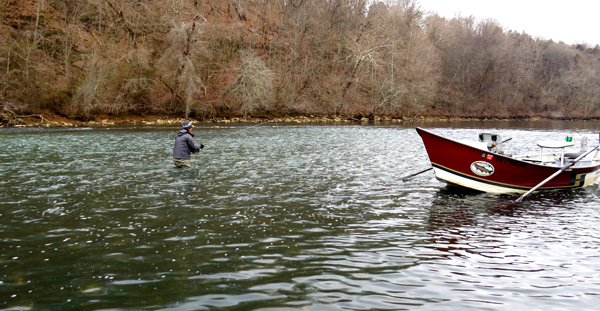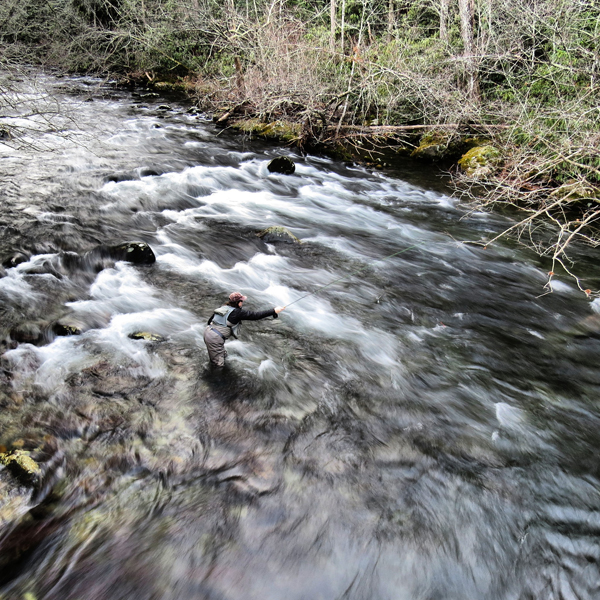Every day we help people catch fish on the fly and a big part of that is helping them to improve their cast. We don’t usually have much time and most people are far more interested in catching fish than spending time on casting lessons. Fortunately we’re pretty good at diagnosing casting problems and giving advice to fix them. Over the many years we’ve spent guiding and instructing we’ve found that there are several things anyone can do to cast more accurately. After all, you’re more likely to catch a fish if you put the fly exactly where it should go.
Cast to a Precise Target
One of the most common things we notice among fly fishers, even experienced ones, is that they will tend to cast their fly to a general area and not cast precisely to an exact target. This is no different than shooting a bow or a rifle where the best advice is “aim small and miss small”. If you cast your fly to a general area it will land somewhere in that general area. As a result your eye will search across that area to find where your fly landed.
A much better strategy is to pick a spot about the size of a tea cup to aim for. Even if you miss, chances are quite good that even if you miss the “tea cup” your fly will probably be within the space of a dinner plate. This is quite easy to see when your eye scans the water for the fly. Even better, you’ll have a good idea of when you should mend line and you’ll be less likely to miss fish since you can see the fly.
Look at the Target While You Are Casting
I’m not sure if I would be aware of this if I didn’t guide for a living and spend well over 100 days a year on the water with fly fishers. You probably don’t even realize it, but many fly fishers watch anything BUT their target when they cast. Here in the Smokies many anglers are looking behind them, more concerned with casting around brush than landing the fly on their target. Even on large rivers many fly casters watch their cast in the air. In either situation anglers turn their head to look at the target just as they are making the stroke to drop the fly.
In many situations fly fishers are essentially casting blind, only looking to the target as they are in the process of laying the fly down. This is extremely hard to do even when you’re experienced. On the other hand, it’s far easier to look at your target in advance, watching it the whole time as you make your cast and drop the fly. Your accuracy will absolutely get better. We see it everyday!
Don’t Cast to the Limits of Your Ability
For some reason fly fishers absolutely love casting distance over shorter casts. This is essentially making something much harder than it has to be. Most fly fishers we talk to expect us to have this philosophy because we fish forested streams so much, but guiding on large rivers also gives us plenty of experience to prove that shorter casts are better.
I’m not advocating that you should always make fifteen foot casts, but there is absolutely no need t0 cast over 35′ unless river conditions don’t allow you to wade any closer. Even in the drift boat I try to position anglers at modest distances. Sometimes fly fishers seem to think I don’t believe they are capable of casting further, but I explain that the point is to catch fish, not put on a casting demonstration. Every extra five feet you cast the fly, any small inaccuracy will become magnified. A long cast is further off target than a shorter cast. A shorter cast is more likely to turn over perfectly while a longer cast is more likely to lose energy and pile up.
Even when your long cast is on target it’s anywhere from difficult to impossible to mend line. Even worse, it’s very difficult to get a good hook set on a fish when you have a ton of line to pick up. Missed fish are relatively common at long distances while it’s much easier to get tight on a fish that’s closer.
Wade or Cast, But Never Wade and Cast
One of the easiest things any angler can do is to simplify what they do. The simplest thing you can do is wade into position without casting. I’m always surprised at how many anglers cast and wade at the same time.
Wading in a river or stream is pretty difficult. You rarely hear anyone talk about how easy fly casting is. Both wading and casting are difficult, but they only get harder when you try to do them at the same time. You will not only have an easier time wading, but your casting will only get better when you take your time to get into position with a good footing then you are able to focus all your attention on the cast. You’re also far less likely to slip and fall or spook fish too.



Bill DuPriest says
Excellent advice. Another thing I might add is not to wade too deep for your height. One of my guides was about 6’4″ or so, and when I waded to where he directed–probably only thigh deep on him–I was up to my waist and could barely keep from being swept downstream.
I’ve often wondered–if you are swept off your feet, is there a recommended procedure to recover?
Ian says
Whenever possible we recommend not wading more than knee deep. It’s got to be a pretty big river for it to be necessary to do more than that. If you do get washed down river you want to get on your back and try to backstroke towards the bank in easier water. If you’re in rapids try to ball up so your feet don’t get wedged under a rock. Once you get to calmer water stroke on over to the bank.
BRADLEY S HERSTINE says
Great tips especially casting and wading at the same time. Your liable to end up were or worse.